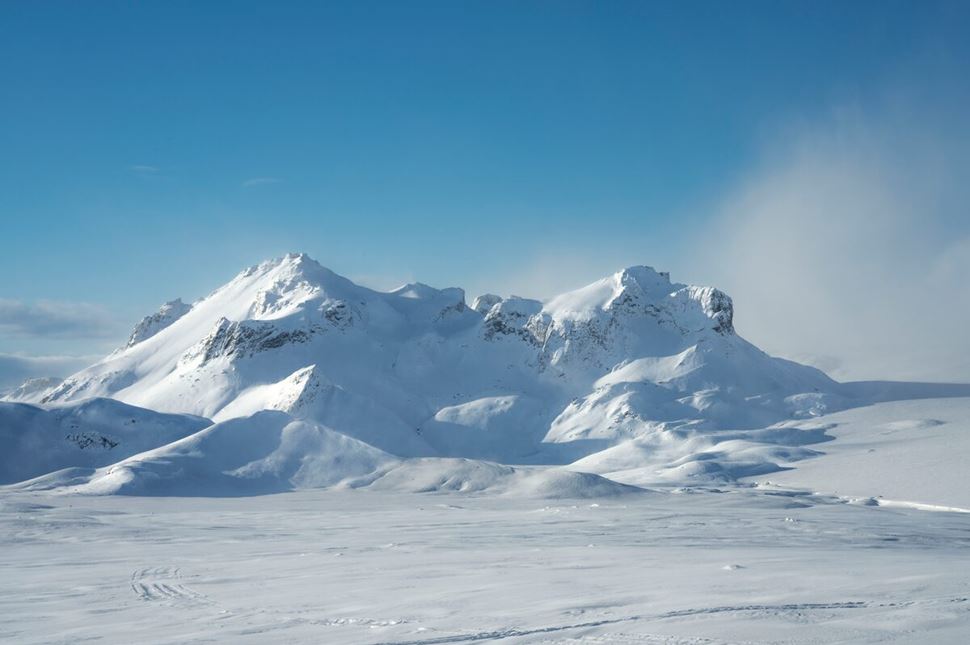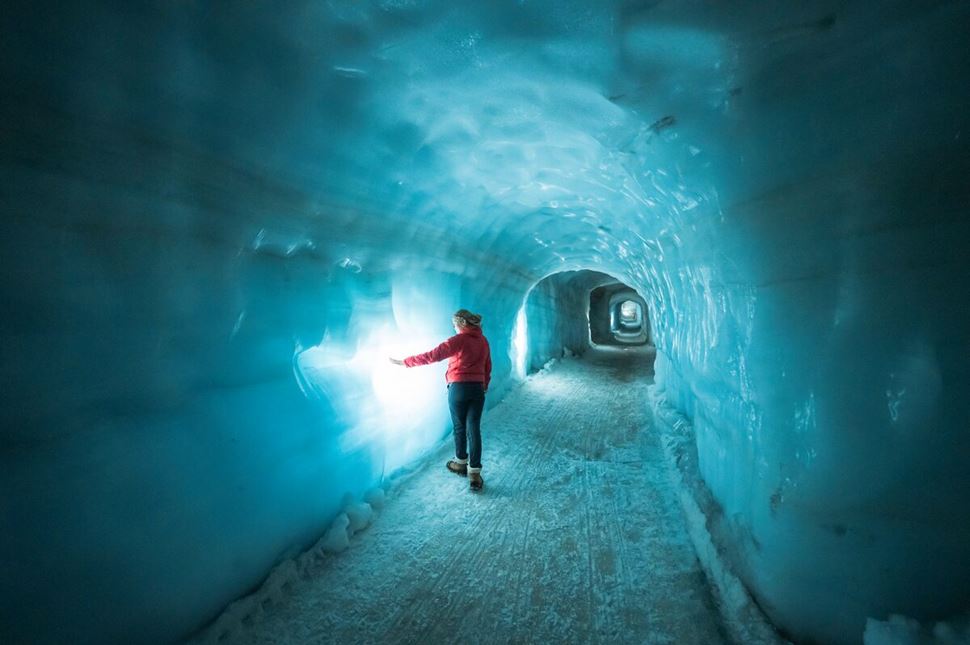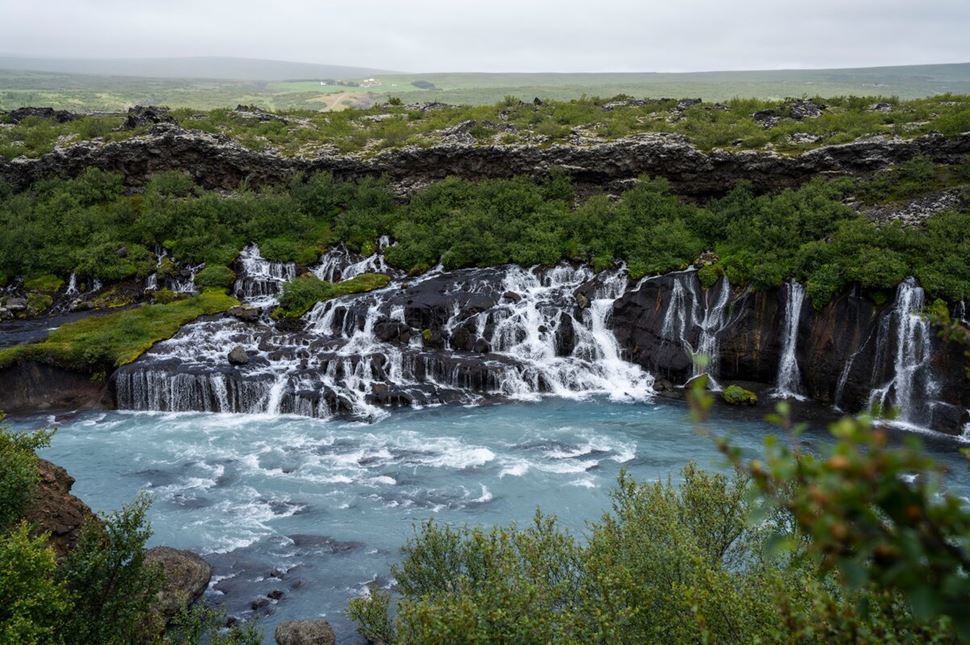Every night could be an aurora night. Don't Miss Out
On the border with the rocky Icelandic highlands, the icy plains of Langjokull Glacier - the second-largest glacier in Iceland - await. The snowy peaks can be seen from popular attractions like Húsafell and Haukadalur. True to its Icelandic name, Langjökull, or “long glacier,” stretches in length, not width. Because of its proximity to the Golden Circle and the capital city of Reykjavik, it has become a top destination for tourists.
The open plains are home to never-ending adventures that range from snowmobiling expeditions to the ice caves - natural or engineered - journeys. Let's learn more about the second-largest glacier in Iceland and why it’s so special together!

The frozen world of Langjokull Glacier. Source: Arctic Adventures.
Langjokull Glacier, Iceland's second-largest ice cap, spans 361 square miles (935 square km). The only Icelandic glacier that surpasses it is the famous Vatnajökull glacier, the largest in Europe. Langjokull stretches approximately 12 miles (20 km) in width and 31 miles (50 km) in length. Once a round glacier, parts of it melted away, with some experts believing it lost 29% of its mass from 1890 to 2019. Some scientists predict it will disappear in the next 150 years.
The glacier’s landscape combines vast snowfields and fascinating icy formations. During winter, natural ice caves form beneath the ice, creating unique sights yearly. Great mountain peaks rise from beneath the glacier, helping create natural borders for explorers. While the views are magnificent, the weather is unforgiving. Strong Icelandic winds pick up light snow from the surface, creating challenging conditions. Temperatures range from 10.4°F (-12°C) in winter to 46.4°F (8°C) in summer.
Langjokull is closely linked to the Golden Circle through its meltwater. Like one of many of the country’s glaciers, it supplies surrounding waterfalls, including Gullfoss, through rivers. The glacier's groundwater takes centuries to emerge at Silfra, a fissure renowned for its crystal-clear waters. Strokkur, a regularly erupting geyser, also owes its activity to Langjokull’s meltwater, which is heated by magma beneath the earth’s surface.
What truly sets Langjokull apart is its accessibility and popularity. With its thrilling experiences and stunning views, Langjokull has become a playground for adventurers and glacier enthusiasts. Snowmobiling, ice caving, and exploring the glacier’s tunnels go perfectly with sightseeing tours and more!

Langjokull Ice Tunnel, captured in May 2025. Photo by: Arctic Adventures.
Langjökull is not just a massive glacier—it's a fascinating natural wonder full of hidden secrets. Want to learn more about it? Here are some fascinating facts about Langjökull:
» Eruptions - The glacier sits atop two active volcanoes that erupt beneath the ice.
» Name - Langjökull was once known as Baldjökull, meaning "round glacier," a nod to its original shape.
» Highest point - The tallest peak of Langjökull reaches an impressive 4,760 feet (1,450 m).
» Historical capsule - The layers of ice hold centuries of history, including ash and pollution from volcanic eruptions over time.
» Eco-system - The glacier's melt-water feeds into Icelandic rivers, while animals have adapted to survive in the harsh, cold environment.
» Into the Glacier - one of the glacier's most remarkable features is the engineered and explorable tunnel.
Langjökull is located in the West of the Icelandic interior or in the Highlands of Iceland and can be seen clearly from Haukadalur Valley. Langjökull is the closest glacier to Reykjavík, Iceland’s capital. To the south are the stunning Gullfoss Waterfall and the tectonic rift in Thingvellir National Park. East of Langjökull, between it and Vatnajökull, lies Hofsjökull, the island's third-largest glacier. In the west is the Silver Circle, composed of Husafell, Deildartunguhver, and Reykholt, among many other wonders. Many tours exploring the glacier begin at the Klaki base camp near its eastern edge. Reykjavik to Langjökull distance is 94 miles (152 km).
Location coordinates: 64.6562° N, 20.1531° W
You can reach the glacier by taking one of two routes, both of which will take around 2.5 hours each way (5 hours for the round trip):
The Golden Circle: Start by heading out on Road 1, then turn onto Route 36. Passing the famous Thingvellir National Park, turn to Route 35. Driving on it, the boiling waters of Geysir Geothermal Area will be on your left, and the stunning Gullfoss Waterfall will be on your right. Continue on the road until you reach the glacier.
Husafell: From Reykjavik, head north on Route 1 and take a right onto Road 50. Continue on this road, following the signs that guide you toward Husafell. Along the way, you'll pass through Reykholt and lush Icelandic forests. The final stretch of the journey is completed on Roads 550 and 551.
While driving up to the glacier alone is possible, we do not recommend it. A 4x4 vehicle and experience navigating the Highlands are essential. Most gravel roads, which are already challenging to navigate in the summer, are closed in winter due to safety concerns. It’s better to book a tour that is led by experienced guides.
Glacier exploration should be one of the top things to do in Iceland for newcomers. Langjökull glacier snowmobiling is an exhilarating experience, letting you drive through the snowy landscape with the wind in your hair and adrenaline rushing through your heart. Some of the best glacier tours include Langjokull glacier ice cave or tunnel expeditions, both renowned for their breathtaking beauty.
What’s better than a hike? Snowmobiling on Langjokull Glacier. Strap on your helmet, press down on the throttle and partake in a must-activity for Icelandic visitors. No wonder most snowmobiling tours in Iceland occur on this glacier - it’s the perfect place! One hour is more than enough to explore the white plains, take in the rare beauty of the ice formations arising from the ground, and the views of the horizon, where mountain rangers of the highlands are plentiful. Due to its location, Langjokull glacier tours from Reykjavik or Gullfoss are popular among first-time travelers.

Visitors exploring newly frozen Langjökull’s natural ice cave during the November 2025 season. Photo by: Gunnar Gaukur.
Are you dreaming of stepping inside the glacier? Ice cave tours in Iceland make the idea of exploring icy chambers a reality. Among the many glaciers you can visit, Langjökull Glacier stands out for giving travelers two distinct ways to explore its frozen world — a naturally formed ice cave that appears each winter and a man-made ice tunnel open year-round.
Every winter, a natural ice cave freezes inside Langjökull, sculpted entirely by the glacier’s movement and meltwater streams. The result is a glowing blue den streaked with black volcanic ash and crystal-clear ice. These caves change every year, making each visit completely unique. The 2025 winter season cave is one of the most beautiful yet, with vivid colors and smooth, sculpted walls that seem to glow from within.

A powerful Super Jeep is used to reach the natural ice cave in winter. Photo by Arctic Adventures.
Access to the natural cave is an adventure in itself. Guests travel across Iceland’s second-largest glacier in a powerful Super Jeep, then continue by snowmobile to reach the hidden entrance. This experience is available only from November to April and offers a rare, close-up encounter with Iceland’s natural ice formations.
>Join the Langjokull glacier ice cave tour to explore the naturally-formed cave that opens every winter.
For those visiting outside the winter months — or anyone preferring an easy, year-round option — Langjökull also houses the world’s largest engineered ice tunnel. This remarkable engineering project was carved directly into the glacier and allows safe, guided exploration in any season. The tunnel maintains steady conditions year-round, with illuminated blue corridors, educational exhibits, and wide walkways suitable for families and all ages.
> See the engineered ice tunnel in Langjökull Glacier and explore it all year round.
To summarize the two ice cave options at Langjokull:
• Natural Ice Cave (Winter Only) — wild, ever-changing, formed by nature, reached by snowmobile, with brilliant translucent ice and a real sense of discovery.
• Man-Made Ice Tunnel (Year-Round) — stable, accessible, educational, and one of a kind in the world.
Langjokull's otherworldly experience is only rivaled by the beauty that surrounds it. Descend the icy slopes back onto the solid ground, and you’ll find the attractions of the Golden Circle, Silver Circle, and numerous waterfalls. So many tourist attractions in Iceland are found around the glacier, but you only need to know the main ones.
Silfra Fissure
Located in Thingvellir National Park in southwest Iceland, Silfra Fissure is one of the best places in the world for snorkeling and seeing the tectonic divide underwater. The clear waters are the meltwaters of Langjokull that take 100 years to emerge. Many visitors stop here as part of the Golden Circle route, making it an unforgettable first destination.
Geysir Geothermal Area
Feeling a chill? Haukadalur Geothermal Area is a mesmerizing stop where the Strokkur geyser erupts spectacularly every few minutes. The boiling water originates from Langjokull, warming up as it passes through magma rocks before bursting through the Earth’s surface. It's hard to miss it as it’s part of the Golden Circle, the second stop on the route.
Gullfoss Waterfall
Where Langjokull woos visitors with its space and excitement, Gullfoss Waterfall wins their hearts with nature's raw power. The roaring cascades, framed by a dramatic canyon, are fueled by the Hvítá River and help create a one-of-a-kind sight. Located on Road 35, Gullfoss marks the final highlight of the Golden Circle route.
Hraunfossar Waterfall

Elegant flows of Hraunfossar waterfall. Photo by Gunnar Gaukur.
What Hraunfossar Waterfall lacks in force, it makes up for in elegance. Known as the “Lava Falls of West Iceland,” the water flows gently through narrow channels of the solidified magma, creating a calming scene. It lies near Husafell and pairs beautifully with Barnafoss.
Barnafoss Waterfalls
A two-for-one deal - can there be a better sightseeing deal? Located west of the glacier, right by Hraunfossar, Barnafoss Waterfalls sees water weaving through small, narrow ravines. Local legends speak of a tragedy here, hence the nickname “Children Falls. Whether it is true or a simple grandma story - we’ll let you decide!
Húsafell
Tucked into a woodland area west of the glacier, the Husafell settlement is a remote paradise. In addition to the few houses and farms hidden behind lines of trees and connected by dirt roads, Húsafell Canyon Baths and Hotel present leisure opportunities for those looking to relax after a snowmobiling or ice-caving experience.
While the glacier's snowy landscape is uninhabitable and harsh, the towns and areas around it host several hotels. Most accommodation options around Langjökull are in Húsafel and near the Golden Circle. Here are the best options:
Hotel Husafell - in the charming village of Húsafell, this hotel combines comfort with adventure. Guests can enjoy various leisure activities, from soaking in nearby hot springs to hiking and outdoor games, making it an ideal base for exploration.
Hotel Gullfoss - between the warm waters of the Geysir area and the breathtaking Gullfoss waterfall, this hotel boasts over 30 years of experience. It blends Nordic charm with contemporary design, creating a cozy yet stylish atmosphere.
Hotel Geysir - across the road from the iconic Strokkur geyser and the Haukadalur Geothermal Area, the hotel is more than just a place to stay. Visitors can indulge in its cafe and restaurant or browse the Geysir Center for clothes and souvenirs, even if they pass through.
Kerlingarfjöll Mountain Resort - tucked away in the highlands near the dramatic volcanic massif of Kerlingarfjöll, this year-round resort is a haven for nature enthusiasts. While reaching it in winter can be challenging due to snowed-in roads, the reward is unparalleled views and an excellent chance to spot the Northern Lights.
Yes, the ice caves of Langjökull are absolutely worth visiting. In winter, you can explore natural caves with vivid blue ice and dramatic volcanic ash layers, reachable on a snowmobile. On the other hand, the Into the Glacier tunnel, open year-round, takes you deep inside the glacier through a glowing blue ice tunnel. Both options are rare, accessible ways to experience Iceland’s frozen world up close.
Technically, yes, you can drive to the glacier. Langjokull is located near two main highland roads that link North and South Iceland. In the summer, you can drive up to the glacier base in a large 4×4 vehicle. In winter, check for road closures before heading to Langjokull. Avoid driving in Iceland's winter conditions, especially in the Highlands, for safety reasons.
Yes, you can visit Langjokull year-round, and there are several ways to explore it. You can take a snowmobiling tour to discover its snowy landscapes or explore the natural ice caves formed by summer meltwaters. Alternatively, you can enter the glacier's heart through the Into the Glacier tunnel.
The glacier can be reached via a combination of paved and gravel roads. Visitors typically approach from Húsafell via F550 or from Gullfoss via Road 35. Due to the terrain, 4x4 vehicles are required for safe travel. Both roads are closed in winter.
Langjokull is 93 miles (150 km) from Reykjavik, making it the closest glacier to the capital. The drive takes about 2 to 2.5 hours. It’s accessible via Golden and Silver Circle routes.
It's difficult to pinpoint the exact age of Langjokull Glacier, but most glaciers in Iceland began forming around 6,000 years ago. They started growing more recently, about 2,500 years ago. The newer snow could be up to 450 years old. The glacier's age is determined by studying the layers of ice.
Langjokull covers an area of 361 square miles (935 square kilometers). It stretches about 50 km (31 miles) long, which is reflected in its name, meaning "long glacier," and is 20 km (12 miles) wide. At its thickest point, the ice is 580 meters (1,903 feet) deep.
Langjökull is Iceland’s top spot for snowmobiling, drawing visitors to its vast white wilderness. Another highlight is the Into the Glacier ice tunnel—a man-made marvel carved deep into the glacier’s core. Since opening, it has welcomed over 320,000 visitors, making it the most popular ice cave experience in the country. Walking through its glowing blue halls is like stepping into another world—and it’s open all year.
No, it’s not recommended to go to Langjökull Glacier on your own. The glacier is remote, constantly changing, and full of hidden dangers like crevasses and soft snow bridges. Ice caves are only accessible with expert guides who scout and monitor them, as their locations shift every season. For safety, you’ll need to join a proper tour.
Langjökull is pronounced as “Lahng-yuh-kutl” ([lauŋkˌjœːkʏtl̥] in Icelandic). “Lang” sounds like "long," but with a more open "a." “Jö” has a soft “j” followed by a short “uh.” "Kull" features a light "tl" sound for the double l's.
The best glacier near Reykjavik is Langjokull, located just 92 miles (150 km) away. It takes about 2.5 hours to drive from the capital to the glacier. The open landscape makes it a popular spot for activities like snowmobiling and ice-caving.
The area around Langjokull offers excellent opportunities for sightseeing. You can experience the classic Silver Circle route, visit its famous attractions, or explore the mountainous Highlands through trekking and hiking tours.
The Into the Glacier tunnel, stretching 1,640 feet (500 meters) into Langjokull, is the longest and largest engineered ice cave in the world. This 14-month project carved a 9.8 by 11.4 feet (3 by 3.5 meters) tunnel into the ice. While it’s a small part of the glacier's overall size, it’s still a remarkable engineering achievement.
Absolutely, snowmobiling on Langjökull Glacier is worth it—both for the thrill and the scenery. You’ll race across one of Iceland’s largest glaciers, surrounded by endless white plains, distant volcanic peaks, and crevassed ice fields. The one-hour ride covers a surprising distance, offering nonstop views and just enough speed to remind you you’re somewhere extreme. It’s a rare way to explore a remote part of Iceland’s frozen interior.
Technically, yes, you can hike at Langjokull Glacier, but it’s not a popular choice. The white, flat fields are ideal for snowmobiles but not great for walking. Instead, the nearby Sólheimajökull outlet and the further away tongue in Skaftafell Nature Reserve are perfect alternatives with much more hiking-friendly views.
Jökulsárlón, Iceland's most famous glacier lagoon, is located on the South Coast, near Vatnajokull, the largest glacier in Europe, at the tip of the Breiðamerkurjökull outlet. The lagoon is about 298 miles (480 km) from Langjokull, or a 7-hour drive. Nearby, Glacier Lake Hvítárvatn sits next to its outlet, Nordurjokull.
Glacier water is typically around 32°F (0°C). As it flows through the Icelandic interior, it gradually warms up. The water can even reach boiling point in geothermal areas and hot springs as it erupts.
|
|
|
|
|
|
Need more information or assistance? We are here to help!